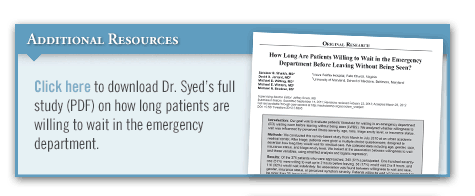As the number of patients seeking emergency care in the United States continues to grow, so too has ED crowding and boarding. “Throughout the country, there has been an increase in volume of ED patients and boarding of patients waiting to be admitted to the hospital,” says Sanober Shaikh Syed, MD. “This can prolong wait times for many patients seeking emergency care. EDs nationwide are struggling to balance demand with capacity.”
Prior studies have shown that the longer patients wait, the more likely they are to leave without being seen (LWBS). These analyses have also revealed that a significant portion of patients who LWBS are classified as needing emergent or urgent medical care. A key question that remains unanswered is how long patients are willing to wait before they choose to LWBS by a healthcare provider.
Waiting Thresholds Before Leaving the ED
Dr. Syed and colleagues conducted a study evaluating patients’ threshold for waiting before they choose to leave the ED waiting room without being seen by an ED provider. The study, published in the Western Journal of Emergency Medicine, also looked at whether willingness to wait was influenced by other factors, including illness severity, age, and insurance status. “Knowing the limits to which patients will wait may be useful in tailoring strategies to reduce wait times,” Dr. Syed says.
In the study, patients who were triaged were given a questionnaire to determine how long they would wait for medical care. The authors also assessed data on age, gender, race, insurance status, and triage acuity level. More than half of the 340 patients who answered the survey were willing to wait up to 2 hours before leaving (Figure). About 17% would wait 2 to 8 hours, and 32% would wait indefinitely. No association was found between willingness to wait and race, gender, insurance status, or perceived symptom severity, according to study results. Patients willing to wait more than 2 hours tended to be older than 25, had higher acuity, and preferred the study site ED (Table 1).
Examining Willingness to Wait in the ED
“At some point, patients may decide that waiting longer to see a physician in the ED waiting room is beyond what they can tolerate,” explains Dr. Syed. “Our study showed that patients whose conditions were classified as higher acuity by nursing triage were more willing to wait beyond 2 hours. We didn’t find the same willingness to wait among patients who classified themselves as being in severe discomfort or having a high level of concern for their symptoms.”
“Knowing the limits to which patients will wait may be useful in tailoring strategies to reduce wait times.”
Although the study did not explore the specific reasons for preferring the study site ED, Dr. Syed says it was not surprising to see that patients reported this preference. “Every ED has its core group of patients who return for treatment of their illnesses,” she says. “Oftentimes, it comes down to convenience of access and location or comfort with the care they’ve received there in the past. When patients balance LWBS with the care they need, it’s likely that this will have an effect on perceived or actual wait times.” Another factor, she says, is whether or not patients feel they can receive the same care at other hospital EDs.
The good news, according to Dr. Syed, is that 96% of patients reported that they would continue to seek services of a healthcare provider for their illness in situations when wait times were excessive. “Many patients reported that they would see their primary care physician the following day or visit another facility the same day [Table 2]. Others reported that they’d return to the same ED later in the day or just wait indefinitely.”
Guiding Decisions for ED Care
Decreasing the number of patients who LWBS is an important goal throughout the U.S. Dr. Syed says the findings from her study team’s analysis can serve as a guide to support capacity management decisions. “It’s important to recognize that the healthcare risks and lost revenue from patients who LWBS are defined by time constraints. It’s reassuring that few patients presenting to the ED for care will forego the services of a physician completely. Knowing that most patients have a defined, limited period that they’re willing to wait can help direct strategies for enhancing care so that there are fewer patients who LWBS.”



